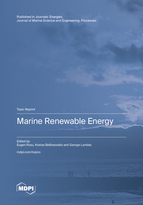Topic Menu
► Topic MenuTopic Editors

2. CENTEC - Centre for Marine Technology and Ocean Engineering, University of Lisbon, Lisbon, Portugal


Marine Renewable Energy

A printed edition is available here.
Topic Information
Dear Colleagues,
We would like to invite submissions to this Topic on the subject of Marine Renewable Energy.
Marine Renewable Energy (MRE) is abundant, and there are large spaces in both offshore and coastal environments that can be considered for harvesting various kinds of marine energy. The effects of climate change have become obvious, and a drastic reduction in CO2 emissions represents an issue of highly increasing importance. From this perspective, the technologies currently associated with marine renewable energy extraction are very significant for achieving the expected targets in energy efficiency and environmental protection. Research into offshore wind has experienced significant success in the last decade and is expected to advance other MRE sources. On the other hand, although significant advances have been noticed in recent years, with regard to extracting marine renewable energy, there are still important challenges related to the implementation of cost-effective technologies that could survive in the harsh marine environment. From this perspective, this Topic seeks to contribute to the renewable energy agenda through enhanced scientific and multi-disciplinary works, aiming to improve knowledge and performance in harvesting ocean energy. We strongly encourage papers providing innovative technical developments, reviews, case studies, and analytics, as well as assessments and manuscripts targeting different disciplines, which are relevant to harvesting ocean energy and to the associated advances and challenges.
Prof. Dr. Eugen Rusu
Prof. Dr. Kostas Belibassakis
Dr. George Lavidas
Topic Editors
Keywords
- marine environment
- offshore and floating wind
- tide and wave energy
- floating solar energy
- osmotic energy
- power to X systems
- storage systems
- resource assessment
- hybrid against colocation concepts
- multi-platform concepts
- arrays of energy converters
- numerical modelling
- laboratory experiments
- climate change and environmental impact
- regulatory, market and financial challenges
- industrial design and manufacturing processes
- marine spatial planning issues
- economic assessments
Participating Journals
| Journal Name | Impact Factor | CiteScore | Launched Year | First Decision (median) | APC |
|---|---|---|---|---|---|

Energies
|
3.2 | 5.5 | 2008 | 16.1 Days | CHF 2600 |

Journal of Marine Science and Engineering
|
2.9 | 3.7 | 2013 | 15.4 Days | CHF 2600 |

Inventions
|
3.4 | 5.4 | 2016 | 17.4 Days | CHF 1800 |

Processes
|
3.5 | 4.7 | 2013 | 13.7 Days | CHF 2400 |

MDPI Topics is cooperating with Preprints.org and has built a direct connection between MDPI journals and Preprints.org. Authors are encouraged to enjoy the benefits by posting a preprint at Preprints.org prior to publication:
- Immediately share your ideas ahead of publication and establish your research priority;
- Protect your idea from being stolen with this time-stamped preprint article;
- Enhance the exposure and impact of your research;
- Receive feedback from your peers in advance;
- Have it indexed in Web of Science (Preprint Citation Index), Google Scholar, Crossref, SHARE, PrePubMed, Scilit and Europe PMC.

